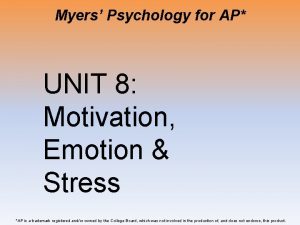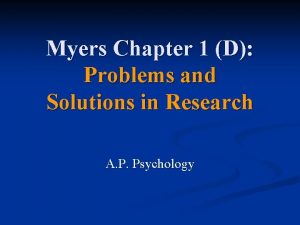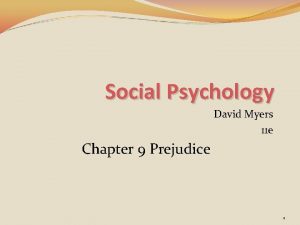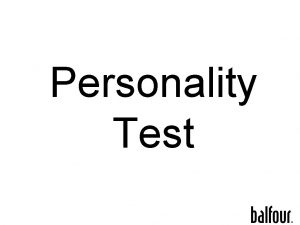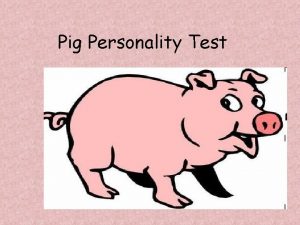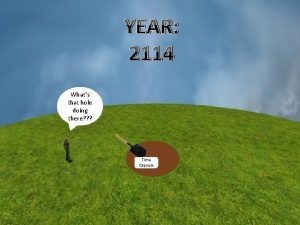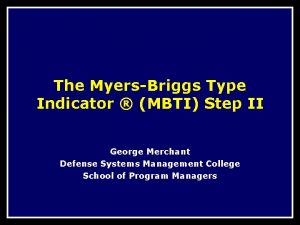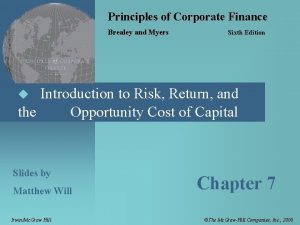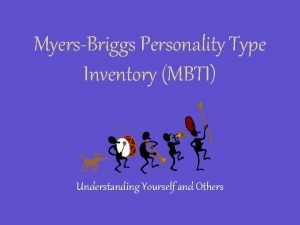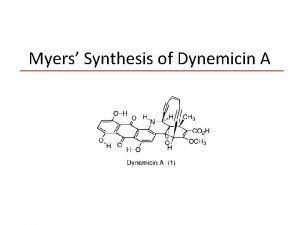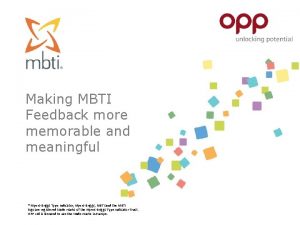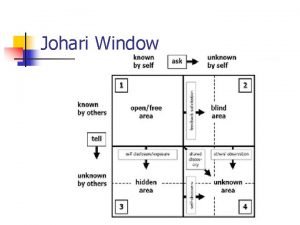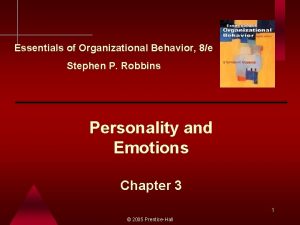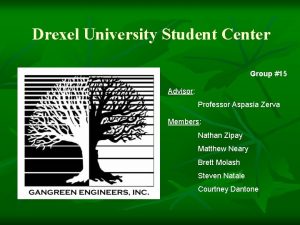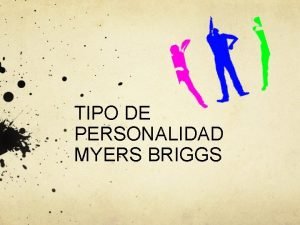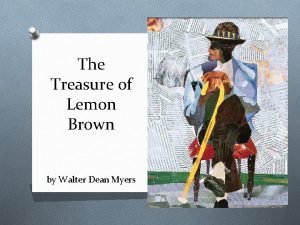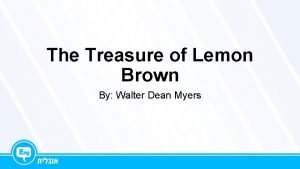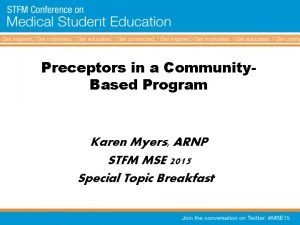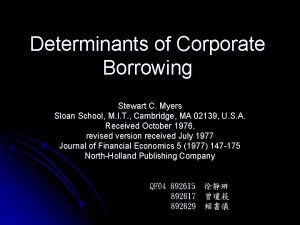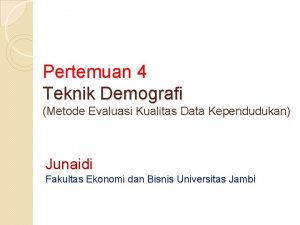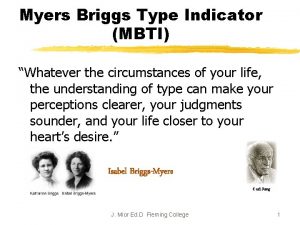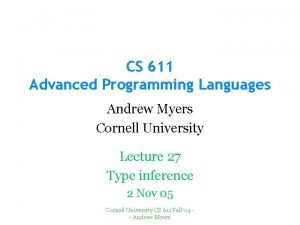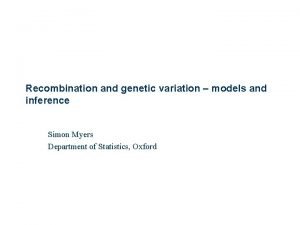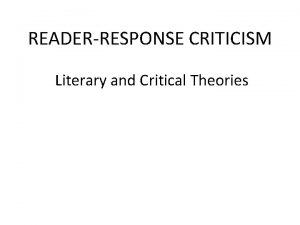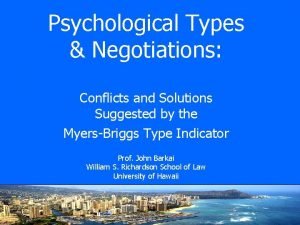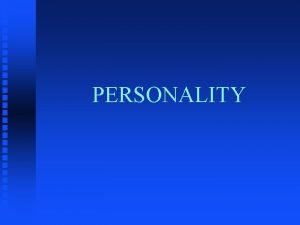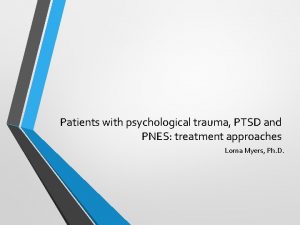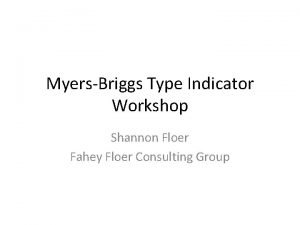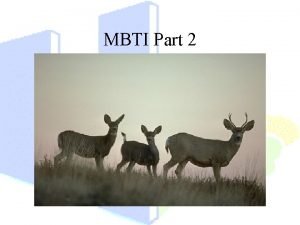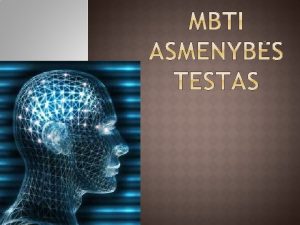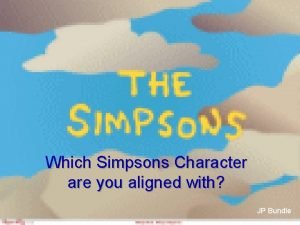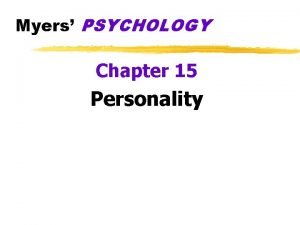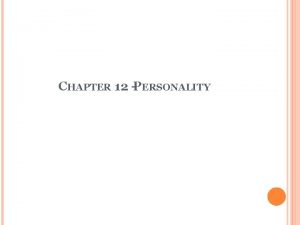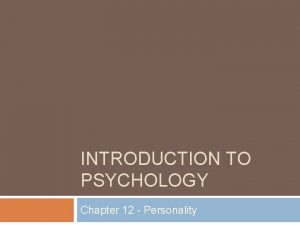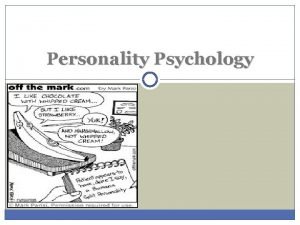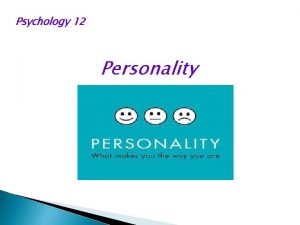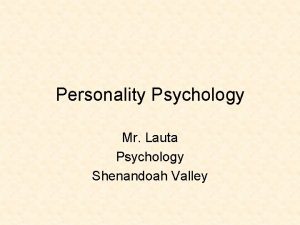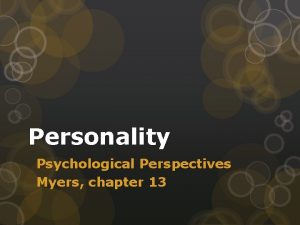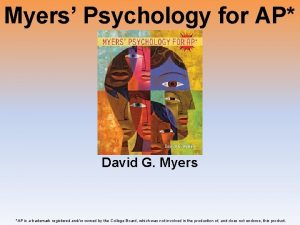Myers PSYCHOLOGY Chapter 15 Personality What is Personality


























































- Slides: 58

Myers’ PSYCHOLOGY Chapter 15 Personality

What is Personality? § Personality § an individual’s characteristic pattern of thinking, feeling, and acting § This chapter emphasizes our individuality § Basic perspectives § Psychoanalytic § Humanistic

The Psychoanalytic Perspective § From Freud’s theory which proposes that childhood sexuality and unconscious motivations influence personality

The Psychoanalytic Perspective § Psychoanalysis § His psychoanalytic theory was the first theory on personality § Freud’s theory of personality that attributes our thoughts and actions to unconscious motives and conflicts § techniques used in treating psychological disorders by seeking to expose and interpret unconscious tensions

Exploring the Unconscious § Believed that things could be explained by examining the unconscious § Started with hypnosis and moved to free association § Free Association § Told the patient to relax and say whatever came to mind § Allowed him to retrace the line of thought to the unconscious

Iceberg! Ego Conscious mind Unconscious mind Superego Id

The Psychoanalytic Perspective § Unconscious § According to Freud, a reservoir of mostly unacceptable thoughts, wishes, feelings and memories § He believed that we repress these because they would be too unsettling to acknowledge § Contemporary viewpoint - information processing of which we are unaware (preconscious)

Personality Structure § Personality, including emotions and strivings, arise from a conflict between our aggressive, pleasure-seeking biological impulses and the internalized social constraints against them § 3 interacting systems: id, ego, superego

Personality Structure - ID § Operates on the pleasure principle, demanding immediate gratification § Concerned with what you want to do § Newborn crying out to be fed or changed – cares nothing about the outside world’s condition or demands (100% at birth) § Get what we want today at the sacrifice of tomorrow

Personality Structure - Ego § Forms at 2 -3 years as we learn to cope with the real world § Operates on the reality principle § Seeks to satisfy the id in realistic ways – rational, thoughtful § Contains our partly conscious perceptions, thoughts, judgments and memories § Concerned with planning what you can do

Personality Structure - Superego § Develops around 5 years old § The voice of conscience – moral part of our personality § Forces the ego to consider not only the real but the ideal - How we ought to behave § Strives for perfection, judging actions, and producing positive feelings of pride or negative feelings of guilt § Superego often opposes the id the ego struggles to reconcile the two

Scenarios v You find some money laying on the floor next to your locker. Nobody else seems to notice the money on the floor. v A student is walking out of the computer lab. When you enter, you see a some nice headphones laying on the floor near where the student was sitting. v You forgot to do your homework that is due after lunch. You have time to complete it but you also know some students who have completed the assignment.

“Cat in the Hat” v We are now going to read “Cat in the Hat” by Dr. Seuss v As you read, identify the actions of the characters as either being driven by the id, ego, or superego.

Personality Development § Freud believed that personality formed in the first few years of life (and from unresolved conflicts in those first few years) § Psychosexual Stages § the childhood stages of development during which the id’s pleasure-seeking energies focus on distinct erogenous zones

Personality Development Freud’s Psychosexual Stages Stage Focus Oral (0 -18 months) Pleasure centers on the mouth-sucking, biting, chewing Anal (18 -36 months) Pleasure focuses on bowel and bladder elimination; coping with demands for control Pleasure zone is the genitals; coping with incestuous sexual feelings Phallic (3 -6 years) Latency (6 to puberty) Dormant sexual feelings Genital (puberty on) Maturation of sexual interests

Personality Development § Oedipus Complex § Phallic stage § a boy’s sexual desires toward his mother and feelings of jealousy and hatred for the rival father § Girls = electra complex § Identification § the process by which children incorporate their parents’ values into their developing superegos § Move out of complexes of phallic stage § “Can’t beat ‘em, so join ‘em” § Identification with same-sex parent § Fixation § a lingering focus of pleasure-seeking energies at an earlier psychosexual stage, where conflicts were unresolved; results in maladaptive behavior in adult life § Smokers or over-eaters fixate in the oral stage

Defense Mechanisms § Anxiety is the price we pay for living in society § We must control our sexual and aggressive impulses § Ego fears losing control of the inner battle between the id and superego § Defense Mechanisms § the ego’s protective methods of reducing anxiety by unconsciously distorting reality § Repression § the basic defense mechanism that banishes anxietyarousing thoughts, feelings, and memories from consciousness

Defense Mechanisms § Regression - defense mechanism in which an individual faced with anxiety retreats to a more infantile psychosexual stage, where some psychic energy remains fixated

Defense Mechanisms § Reaction Formation § defense mechanism by which the ego unconsciously switches unacceptable impulses into their opposites § people may express feelings that are the opposite of their anxiety-arousing unconscious feelings

Defense Mechanisms § Projection - defense mechanism by which people disguise their own threatening impulses by attributing them to others § Rationalization - defense mechanism that offers self-justifying explanations in place of the real, more threatening, unconscious reasons for one’s actions

Defense Mechanisms § Displacement - defense mechanism that shifts sexual or aggressive impulses toward a more acceptable or less threatening object or person (redirecting anger toward a safer outlet)

Defense Mechanisms § Denial – Blocking a threatening idea, memory, or emotion external events from awareness § Sublimation – Similar to displacement, but takes place when we manage to displace our emotions into a constructive rather than destructive activity.

Neo-Freudian/Psychodynamic Ø Accepted Freud’s ideas of: § § Id, ego, superego Importance of unconscious Shaping of personality in childhood Dynamics of anxiety/defense mechanisms Ø Different in 2 important ways: § Placed more emphasis on the conscious mind’s role in interpreting and in coping with the environment § Doubted that sex and aggression were allconsuming motivations

Adler and Horney z. Social, not sexual tensions are crucial for personality development z. Much of our behaviors is driven by efforts to conquer childhood feelings of inferiority y. Hence, why we strive for superiority and power z. Child’s sense of helplessness leads to desire for love and security

Carl Jung z. Freud disciple turned dissenter z. Unconscious contains more than just our repressed thoughts z. Collective unconscious: a common reservoir of images derived from our species’ universal experiences z. Explains why, for many people, spiritual concerns are deeply rooted and why people in different cultures shared certain myths and images (i. e. mother=nurturance)

Post-Freud z. Psychodynamic theory z. Not wed to the idea of sex as the basis of personality z. Do feel that much of our mental life in unconscious z. That we struggle with inner conflicts between wishes, fears, values z. That childhood shapes our personalities and how we become attached to others

Assessing the Unconscious § How do we evaluate personality if it is in the unconscious? § Projective Test § a personality test, such as the Rorschach or TAT, that provides ambiguous stimuli designed to trigger projection of one’s inner dynamics § Thematic Apperception Test (TAT) § a projective test in which people express their inner feelings and interests through the stories they make up about ambiguous scenes § Draw a person, sentence completion first word that comes to mind after a test word is said

Assessing the Unconscious § Rorschach Inkblot Test § the most widely used projective test § a set of 10 inkblots designed by Hermann Rorschach § seeks to identify people’s inner feelings by analyzing their interpretations of the blots § Assumes that we see in the inkblots reflects our inner feelings and conflicts § If we see predatory animals or weapons the examiner may infer that we have aggressive tendencies

Assessing the Unconscious--Rorschach

Your Turn! z Homework…go to: http: //stupidstuff. org/main/rorschach. htm z Take the test y. Look at the inkblot before you look at the choices y. Jot down what comes to mind – do NOT study it and try to make meaning out of it (it is not abstract art) z Then, when you are done with all 10 print out your results and give your reaction in 1 -2 paragraphs. y. Do you buy it? Is it accurate? Was it useful? Meaningless? Garbage? Could it be meaningful? xtry to ignore the web page name ; ) y. Is it reliable and valid?

Too Negative and We Are All Sick? z. By the 1960’s people were sick of Freud and his followers z. Felt they were too negative z. Along came humanistic psychologists z. They focused on what “healthy” people z. Not based on science z. They studies people through self-reported experiences and feelings

Abraham Maslow § Abraham Maslow (19081970) § studied selfactualization processes of productive and healthy people (e. g. , Lincoln)

Needs Maslow argued that we are motivated by a hierarchy of needs We move up the needs until we reach selfactualization

More on Maslow z Studied healthy creative people – not troubled clinical cases y. People who seemed to have rich and productive lives z. He said they all shared certain characteristics y. Self-awareness, self-acceptance, open, spontaneous, loving, caring and not paralyzed by others’ opinions y. Lincoln, Jefferson, and Eleanor Roosevelt y. Interests were problem-centered rather than self centered

Humanistic Perspective § Self-Actualization § the ultimate psychological need that arises after basic physical and psychological needs are met and selfesteem is achieved § the motivation to fulfill one’s potential

Carl Rogers § People are naturally good and are endowed with self-actualizing tendencies § Focused on growth and fulfillment of individuals § genuineness § acceptance § empathy

Rogers Continued § Unless we are thwarted by an environment that inhibits growth – we will all grow and be fulfilled § Growth requires: genuineness, acceptance, and empathy § People must be genuine with us – open with their feelings § Accepting through unconditional positive regard § Empathetic by sharing and mirroring our feelings

Acceptance and Unconditional Positive Regard § How people are “accepting” § an attitude of total acceptance toward another person § People value us even though they know our failings § We can be who we are without fearing losing their esteem, respect or love

Self-Concept § Central feature of personality § all of our thoughts and feelings about ourselves, in an answer to the question, “Who am I? ” § Positive self-concept=positive perception of the world § Negative self-concept=negative perception of the world

Assessing Self z. Questionnaires and surveys to “get to know yourself” z. How do you see yourself ideally and how are you actually? z. When ideal and actual are nearly alike then self-concept is positive z. Some say this is depersonalizing y. Interviews and intimate conversations provide a better understanding

Criticism of Humanistic Theory z. Concepts are vague and subjective z. Is it scientific or just a measure of personal values? z. Fails to account for our capacity for evil z. Rogers said that the only question to ask was if, “Am I living in a way which is satisfying to me, which truly expresses me? ” y. Trust and act on own feelings can mean lead to self-indulgence, selfishness, and reosion of moral restraints

End Day z. Worksheet z. Enhancing Your Understanding of the Humanistic Perspective

Contemporary Research-The Trait Perspective § Trait § a characteristic pattern of behavior § a disposition to feel and act, as assessed by self-report inventories and peer reports § Personality Inventory § a questionnaire (often with true-false or agree -disagree items) on which people respond to items designed to gauge a wide range of feelings and behaviors § used to assess selected personality traits

The Trait Perspective Moody Anxious Rigid Sober Pessimistic Reserved Unsociable Quiet UNSTABLE § Hans and Sybil Eysenck use two primary personality factors as axes for EXTRAVERTED describing personality sanguine variation Sociable Touchy Restless Aggressive Excitable Changeable Impulsive Optimistic Active melancholic choleric INTROVERTED phlegmatic Passive Careful Thoughtful Peaceful Controlled Reliable Even-tempered Calm Outgoing Talkative Responsive Easygoing Lively Carefree Leadership STABLE

The Trait Perspective § Minnesota Multiphasic Personality Inventory (MMPI) § the most widely researched and clinically used of all personality tests § originally developed to identify emotional disorders (still considered its most appropriate use) § now used for many other screening purposes

The Trait Perspective § Empirically Derived Test § a test developed by testing a pool of items and then selecting those that discriminate between groups § such as the MMPI

The Trait Perspective Clinically significant range Hypochondriasis 1 (concern with body symptoms) Depression 2 (pessimism, hopelessness) After treatment (no scores in the clinically significant range) Hysteria 3 (uses symptoms to solve problems) Psychopathic deviancy 4 (disregard for social standards) Before treatment (anxious, depressed, and displaying deviant behaviors) Masculinity/femininity 5 (interests like those of other sex) Paranoia 6 (delusions, suspiciousness) Psychasthenia 7 (anxious, guilt feelings) Schizophrenia 8 (withdrawn, bizarre thoughts) Hypomania 9 (overactive, excited, impulsive) Social introversion 10 (shy, inhibited) 0 30 40 50 60 T-score 70 80 § Minnesota Multiphasic Personality Inventory (MMPI) test profile

The Trait Perspective The “Big Five” Personality Factors Trait Dimension Description Emotional Stability Calm versus anxious Secure versus insecure Self-satisfied versus self-pitying Extraversion Sociable versus retiring Fun-loving versus sober Affectionate versus reserved Openness Imaginative versus practical Preference for variety versus preference for routine Independent versus conforming Extraversion Soft-hearted versus ruthless Trusting versus suspicious Helpful versus uncooperative Organized versus disorganized Careful versus careless Disciplined versus impulsive Conscientiousness

Social-Cognitive Perspective § views behavior as influenced by the interaction between persons and their social context § Reciprocal Determinism § the interacting influences between personality and environmental factors

Social-Cognitive Perspective

Social-Cognitive Perspective § Personal Control § our sense of controlling our environments rather than feeling helpless § External Locus of Control § the perception that chance or outside forces beyond one’s personal control determine one’s fate

Social-Cognitive Perspective § Internal Locus of Control § the perception that one controls one’s own fate § Learned Helplessness § the hopelessness and passive resignation an animal or human learns when unable to avoid repeated aversive events

Social-Cognitive Perspective § Learned Helplessness Uncontrollable bad events Perceived lack of control Generalized helpless behavior

Social-Cognitive Perspective § Positive Psychology § the scientific study of optimal human functioning § aims to discover and promote conditions that enable individuals and communities to thrive

Exploring the Self § Spotlight Effect § overestimating others noticing and evaluating our appearance, performance, and blunders § Self Esteem § one’s feelings of high or low self-worth § Self-Serving Bias § readiness to perceive oneself favorably

Exploring the Self § Individualism § giving priority to one’s own goals over group goals and defining one’s identity in terms of personal attributes rather than group identifications § Collectivism § giving priority to the goals of one’s group (often one’s extended family or work group) and defining one’s identity accordingly

Exploring the Self Value Contrasts Between Individualism and Collectivism Concept Individualism Collectivism Self Independent (identity from individual traits) Interdependent identity from belonging) Life task Discover and express one’s uniqueness Me--personal achievement and fullfillment; rights and liberties Maintain connections, fit in What matters We-group goals and solidarity; social responsibilities and relationships Coping method Change reality Accommodate to reality Morality Defined by individuals (self-based) Defined by social networks (duty-based) Relationships Many, often temporary or casual; confrontation acceptable Few, close and enduring; harmony valued Attributing behaviors Behavior reflects one’s personality and attitudes Behavior reflects social and roles

The Modern Unconscious Mind § Terror-Management Theory § Faith in one’s worldview and the pursuit of self-esteem provide protection against a deeply rooted fear of death
 David myers psychology 9th edition
David myers psychology 9th edition Unit 8 myers ap psychology
Unit 8 myers ap psychology Psychology eighth edition david g myers
Psychology eighth edition david g myers Myers psychology for ap
Myers psychology for ap Reuptake psychology
Reuptake psychology Psychology ninth edition david g myers
Psychology ninth edition david g myers Myers' psychology for ap solutions
Myers' psychology for ap solutions Psychology tenth edition in modules
Psychology tenth edition in modules Social psychology david myers
Social psychology david myers Psychology in everyday life myers
Psychology in everyday life myers Myers' psychology for ap
Myers' psychology for ap Personality pig
Personality pig Pig drawing personality test
Pig drawing personality test Social facilitation example psychology
Social facilitation example psychology Walter dean myers
Walter dean myers Bad boy walter dean myers summary
Bad boy walter dean myers summary Mr irwin lasher
Mr irwin lasher Mbti step ii
Mbti step ii Binary counting sequence
Binary counting sequence Finance brealey and myers
Finance brealey and myers Artisan personality type
Artisan personality type Andrew g. myers
Andrew g. myers Monster by walter dean myers vocabulary
Monster by walter dean myers vocabulary Monster walter dean myers vocabulary
Monster walter dean myers vocabulary Mbti
Mbti Window to window mbti
Window to window mbti Tony robbins myers briggs
Tony robbins myers briggs Drexel university myers hall
Drexel university myers hall Bridge to terabithia chapter 3 and 4 questions and answers
Bridge to terabithia chapter 3 and 4 questions and answers 5 voices guardian
5 voices guardian Gruneberg and myers
Gruneberg and myers Walter dean myers bad boy summary
Walter dean myers bad boy summary Arquitecto mbti
Arquitecto mbti Summary of the treasure of lemon brown
Summary of the treasure of lemon brown The treasure of lemon brown
The treasure of lemon brown Aarian afshari
Aarian afshari A-m-t management performance ag
A-m-t management performance ag Stewart myers mit
Stewart myers mit Indeks myers adalah
Indeks myers adalah Estj 中文
Estj 中文 True colors word sort
True colors word sort Bad boy by walter dean myers
Bad boy by walter dean myers Myers–briggs type indicator
Myers–briggs type indicator Walter dean myers biography
Walter dean myers biography Myers blended index
Myers blended index Andrew myers cornell
Andrew myers cornell Jacobian myers
Jacobian myers Lou myers gay
Lou myers gay Isfj
Isfj Mmpi vs myers briggs
Mmpi vs myers briggs Lorna myers pnes
Lorna myers pnes Isabel briggs myers
Isabel briggs myers Mbti istj
Mbti istj Mbti testas
Mbti testas Brad myers cmu
Brad myers cmu Myers briggs strengths and weaknesses
Myers briggs strengths and weaknesses Wide area network wan fort myers
Wide area network wan fort myers Infp simpsons
Infp simpsons Setting of lemon brown
Setting of lemon brown

